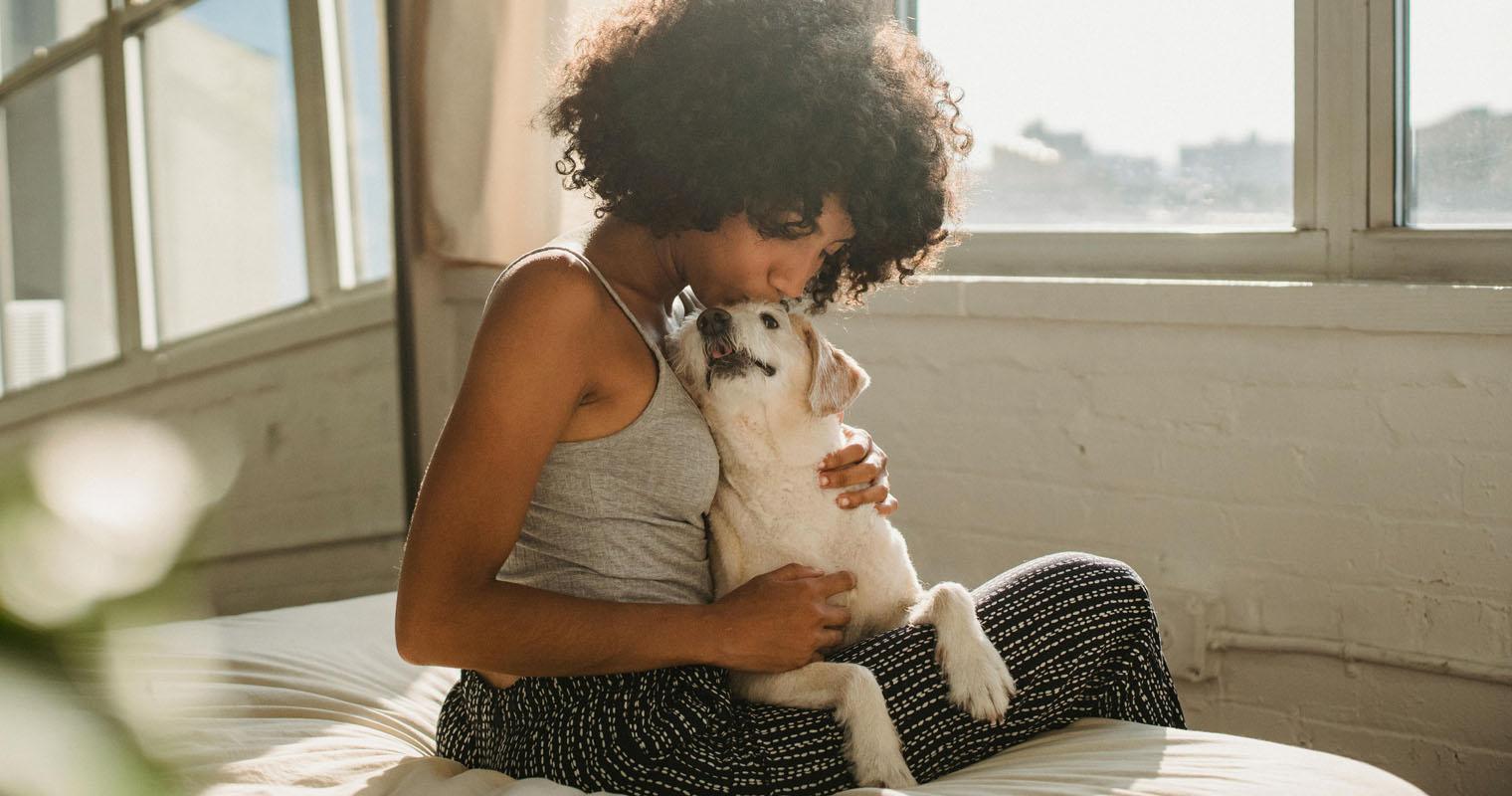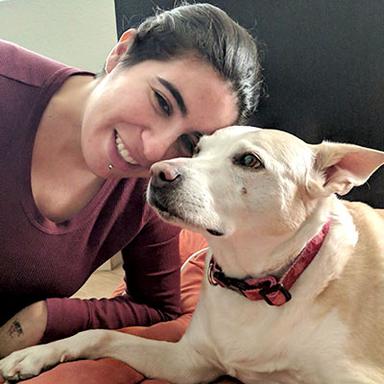Separation Anxiety In Dogs: How To Stop Dog Barking When Left Alone?
Does your dog experience separation anxiety? Explore helpful techniques to comfort and entertain your dogs while they
Does your dog experience separation anxiety? Explore helpful techniques to comfort and entertain your dogs while they
by Daniela Lopez, | February 24, 2024

Samson Katt / Pexels
Separation anxiety in dogs takes many forms and has many different levels of intensity, but one of the most obvious signs is a dog crying, howling, barking, or otherwise vocalizing when left alone. Your canine crooner may not be hurting themself or anyone (or anything!) with this behavior, but unless you live in a soundproof studio or way out in the country, dogs howling can certainly cause problems with your neighbors. Also, it is a very audible communication from your dog to you, or whoever might be within earshot, that they’re unhappy.
Your dog may have felt abandoned before, and if they’re not well-balanced through training, routine, and exercise, losing their protector can feel unbearable. The good news is there are things you can try to reduce and eliminate separation anxiety when left alone.
Separation anxiety occurs when a dog experiences fear or panic when left alone, either after a specific person leaves or if they’re totally alone. “Dogs are social creatures, they want to be with their people, and they do not want to be alone,” says dog trainer Julie Chang, PhD, CTC of The Life of Kai. “Sometimes, separation anxiety can be managed using different strategies. They can be taught to feel okay when being alone.”
Some newly adopted dogs may vocalize when they are first left alone as they are still getting used to their new home. Even dogs you’ve had for a while can be upset by changes in their routine, such as your work hours changing, a new roommate, etc., which can lead to separation anxiety.
Dogs experiencing separation anxiety tend to exhibit more severe behaviors than dogs who are just bored or frustrated. Bored dogs may alternate between barking, sleeping, chewing, or becoming mischievous when their parent is away, but dogs experiencing separation anxiety will really freak out because they are overwhelmed by fear. “Frustrated or bored dogs are typically less persistent when expressing the behaviors whereas a fearful and anxious dog is not as logical; they can vocalize for hours,” says Chang.
Separation anxiety is not just an adult thing. Puppies can get separation anxiety, too. “Bad early life experiences can create fear even in puppies. Many assume that puppies are too young to have bad experiences,” says Chang. “Remember that fear can derive from maternal experiences while [in the womb] or early bad experiences that happen with a litter if mom was unable to care for them, or they were hungry because mom was not healthy. We often see this with pregnant, reduced stray mamas.”
But not all puppies who chew on table legs or howl when you leave are experiencing separation anxiety. While it is true that puppies can develop separation anxiety, younger dogs are more likely to feel frustrated than anxious.
Common symptoms of anxiety in dogs include drooling, hiding, shaking, panting, excess energy, aggression, and destruction. Humans can also notice signs before they leave, including pacing, panting, pulling their ears back, following you around, hiding, or refusing food.
The most obvious sign — and one that can potentially be the most problematic for everyone involved — is crying or excessive barking when you leave. Dogs cry or whine for a number of reasons, but in this case, they’re generally expressing their uncertainty and anxiety.
You can help alleviate your dog’s separation anxiety with training, specifically through desensitization. When desensitizing a dog, the idea is to help your dog understand that nothing bad happens when they’re alone. When desensitizing your dog through training, go at your dog’s pace by doing short incremental training sessions. “It’s recommended that you work on home-alone training four to five times a week. The training starts with the duration the dog can be alone without stress,” says Chang. For some dogs, that duration is five seconds. For others, it might only be three — it is individual to the dog.
The length of the training program required to help them overcome their separation anxiety varies depending on the individual dog too. “The recommended training time is usually eight weeks. The goal is for the dog to be alone at least for 15 minutes, but for some dogs, eight weeks is not enough.”
Chang recommends investing in an indoor video camera before getting started. It will allow you to monitor your dog to ensure you return before they exhibit any non-audible feelings of anxiety, such as shadowing and pacing. Here’s a rough outline of how to get started:
You’ll need to determine when your dog begins to freak out about the idea of you leaving. Do they panic when you grab your keys? When you crack the door? Can you go out the door for five seconds or only two? You get the idea. Other potential triggers include taking a shower, making coffee, and putting on shoes. Keep track of this information in a journal to record your dog’s progress.
Work with your dog several times a week to help build their tolerance while also keeping them calm and comfortable. If your dog can remain calm while you walk up to your door, as long as you don’t touch it, then practice that. “If keys are a departure cue, we advise the pet parents to go ahead and put keys in their pocket hours before they know they have to leave. It’s just one less thing to desensitize,” says Chang. “Touching the doorknob, however, cannot be minimized. So we have them work on the doorknob and just pocket the keys.”
Work at your dog’s pace making only incremental adjustments. Eventually, you’ll work on touching but not turning the doorknob, and so forth. Keep it positive. Wait one to two minutes between each training session.
As your dog gets better at handling your typical routine, mix it up. Try doing things in a different order or for different durations, but again, keep it positive. Here’s an example:
Only go down the hallway to your front door or down the driveway, then come back.
Then go down the hallway or block, wait five minutes, and come back.
Then, actually leave.
When you are getting ready to leave, gather up your things and leave as if you are coming right back. Skip hugs, kisses, or dramatic farewells. Don’t say “Goodbye, sweetie pie!” This just gives your dog a huge alert that you’re leaving.
Follow the same low-key routine when you return. This is the hardest for humans, but ignore any attention-seeking behavior, such as jumping or going crazy, and only reward your dog with calm love and affection when they are calm for at least five minutes after you’ve come home. You can take them outside immediately if they have to go potty but do so calmly without fanfare, as you’d do if you’d been home already.
For some dogs, being around others can help reduce their anxiousness. Doggie daycare can be a daily or occasional way for dogs who enjoy playing with other dogs to get lots of exercise and be happier and less anxious on days when their humans can’t be home with them.
“If pet parents have limited time, they can get the dog to daycare or build a small circle of friends and family to help watch the dog when they cannot,” says Chang. Daily dog walkers or sitters can also add just enough extra exercise and attention into your dog’s routine to alleviate crying when left alone.
When it comes to addressing separation anxiety, positive reinforcement training is crucial. A certified trainer with appropriate credentials can teach you the tools to help your dog cope with separation anxiety. But because of the nature of separation anxiety, professional training can take a long time and be expensive. Expect to pay between $1500 and $2000 for a typical eight-week session. Some trainers, such as Julie Naismith and Malena DeMartini, offer an a la carte approach to separation anxiety training by providing pet parents the ability to connect with a separation anxiety specialist at an easier-to-swallow price.
If all else fails, you can visit your vet to discuss your dog’s behavior. There are a few medications for dogs with separation anxiety, such as Alprazolam or Clomicalm, that your vet can prescribe that may help either relieve anxiety or sedate your dog. For many dogs, medication and training go hand in hand.
“Sometimes medications have to be added to the regimen and may take at least two months to have an effect. During those months, [separation anxiety] training may need to be modified,” says Chang.
You can also try natural anxiety remedies, including experimenting with calming products like calming collars, shirts, and diffusers, but the efficacy of many of these products is anecdotal. Probiotic supplements, available through veterinarians, can also help dogs maintain positive cardiac activity during stressful events, promoting a positive emotional state. It may take up to six weeks to see results, so give yourself plenty of lead time.
What if you sought out a professional and it did not help, or you are unable to make the investment in helping your pup with their separation anxiety? If you’ve realized your dog’s anxiety is not improving or they are under a great deal of stress, rehoming your dog to a family that can better address these needs may be a very kind and responsible choice.
Rehome is a peer-to-peer adoption service that allows pet parents to post their pets on adoptapet.com to be seen by millions of potential adopters. If you’re in the difficult position of considering whether to rehome your dog, it’s important to take an honest look at the situation and do your homework. Rehome can help make the process easy and as safe as possible. When you’ve done all you can, it’s important to remember that pets are individuals, and sometimes your home might not be the right fit.
Adult dogs can generally be left for four to six hours a day, while puppies between three and six months should not be left alone for longer than their age in months.
If your dog is bored, playing the radio or TV, giving them food puzzles, and crate training may help. For dogs with separation anxiety, desensitization training can help reduce their fear and improve their behavior.
Every dog is different, and with training and other methods of intervention, some dogs overcome their separation anxiety in weeks while others take months or even years.
The best home remedy for separation anxiety in dogs is training. Training your dog to be less fearful when alone can help reduce crying and problematic behaviors.
There is no fast way to cure separation anxiety in dogs. Every dog is different, and helping them overcome their fear takes time. Do not rush training, work at your dog’s individual pace.
With training and other methods of intervention, many dogs overcome separation anxiety, but they’ll need the help and guidance of someone they trust.
Risk factors and behaviors associated with separation anxiety in dogs
Evaluation of treatments for separation anxiety in dogs
Canine separation anxiety: strategies for treatment and management

Daniela Lopez is the content manager at Adopt a Pet. As a content strategist, she has previously contributed to The Bark, The Wildest, and more. She has volunteered for several non-profits, including the Alameda Animal Shelter and Lost Our Home Pet Rescue, and is currently a foster for her local SPCA. In her free time, she has two mixed-breed rescue dogs keeping her on her toes.